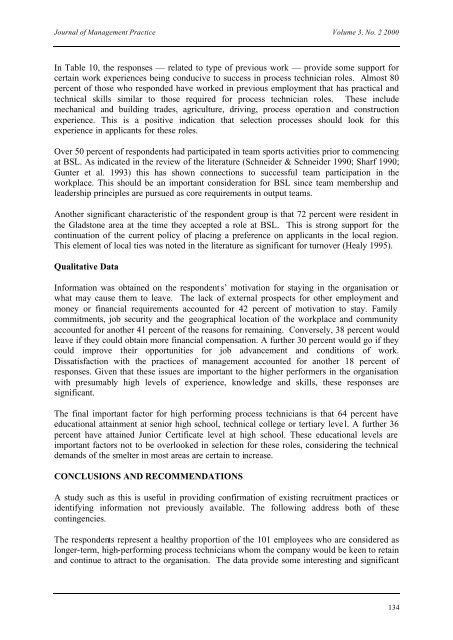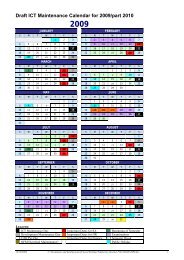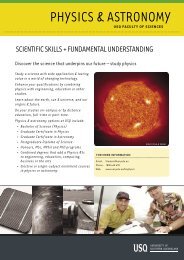a description of the biographical characteristics of process
a description of the biographical characteristics of process
a description of the biographical characteristics of process
You also want an ePaper? Increase the reach of your titles
YUMPU automatically turns print PDFs into web optimized ePapers that Google loves.
Journal <strong>of</strong> Management Practice Volume 3, No. 2 2000In Table 10, <strong>the</strong> responses — related to type <strong>of</strong> previous work — provide some support forcertain work experiences being conducive to success in <strong>process</strong> technician roles. Almost 80percent <strong>of</strong> those who responded have worked in previous employment that has practical andtechnical skills similar to those required for <strong>process</strong> technician roles. These includemechanical and building trades, agriculture, driving, <strong>process</strong> operation and constructionexperience. This is a positive indication that selection <strong>process</strong>es should look for thisexperience in applicants for <strong>the</strong>se roles.Over 50 percent <strong>of</strong> respondents had participated in team sports activities prior to commencingat BSL. As indicated in <strong>the</strong> review <strong>of</strong> <strong>the</strong> literature (Schneider & Schneider 1990; Sharf 1990;Gunter et al. 1993) this has shown connections to successful team participation in <strong>the</strong>workplace. This should be an important consideration for BSL since team membership andleadership principles are pursued as core requirements in output teams.Ano<strong>the</strong>r significant characteristic <strong>of</strong> <strong>the</strong> respondent group is that 72 percent were resident in<strong>the</strong> Gladstone area at <strong>the</strong> time <strong>the</strong>y accepted a role at BSL. This is strong support for <strong>the</strong>continuation <strong>of</strong> <strong>the</strong> current policy <strong>of</strong> placing a preference on applicants in <strong>the</strong> local region.This element <strong>of</strong> local ties was noted in <strong>the</strong> literature as significant for turnover (Healy 1995).Qualitative DataInformation was obtained on <strong>the</strong> respondents’ motivation for staying in <strong>the</strong> organisation orwhat may cause <strong>the</strong>m to leave. The lack <strong>of</strong> external prospects for o<strong>the</strong>r employment andmoney or financial requirements accounted for 42 percent <strong>of</strong> motivation to stay. Familycommitments, job security and <strong>the</strong> geographical location <strong>of</strong> <strong>the</strong> workplace and communityaccounted for ano<strong>the</strong>r 41 percent <strong>of</strong> <strong>the</strong> reasons for remaining. Conversely, 38 percent wouldleave if <strong>the</strong>y could obtain more financial compensation. A fur<strong>the</strong>r 30 percent would go if <strong>the</strong>ycould improve <strong>the</strong>ir opportunities for job advancement and conditions <strong>of</strong> work.Dissatisfaction with <strong>the</strong> practices <strong>of</strong> management accounted for ano<strong>the</strong>r 18 percent <strong>of</strong>responses. Given that <strong>the</strong>se issues are important to <strong>the</strong> higher performers in <strong>the</strong> organisationwith presumably high levels <strong>of</strong> experience, knowledge and skills, <strong>the</strong>se responses aresignificant.The final important factor for high performing <strong>process</strong> technicians is that 64 percent haveeducational attainment at senior high school, technical college or tertiary level. A fur<strong>the</strong>r 36percent have attained Junior Certificate level at high school. These educational levels areimportant factors not to be overlooked in selection for <strong>the</strong>se roles, considering <strong>the</strong> technicaldemands <strong>of</strong> <strong>the</strong> smelter in most areas are certain to increase.CONCLUSIONS AND RECOMMENDATIONSA study such as this is useful in providing confirmation <strong>of</strong> existing recruitment practices oridentifying information not previously available. The following address both <strong>of</strong> <strong>the</strong>secontingencies.The respondents represent a healthy proportion <strong>of</strong> <strong>the</strong> 101 employees who are considered aslonger-term, high-performing <strong>process</strong> technicians whom <strong>the</strong> company would be keen to retainand continue to attract to <strong>the</strong> organisation. The data provide some interesting and significant134
















